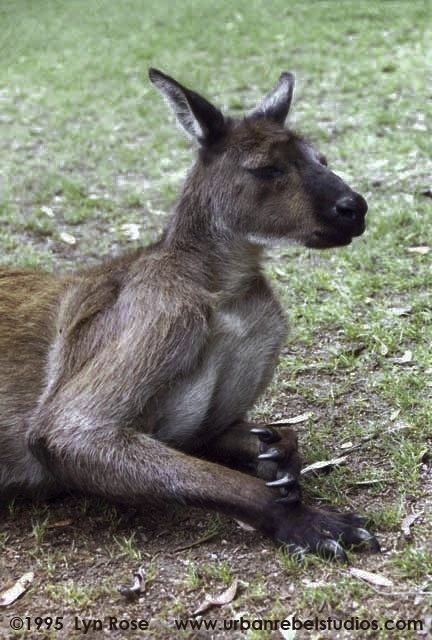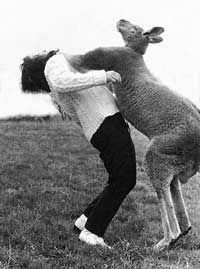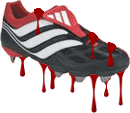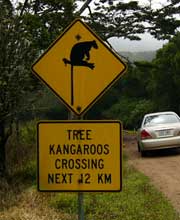 Accommodation | International
Flights | Domestic
Flights | Tours
| Travel
Insurance | Car
Hire | Visas
| Shopping
| Dating
| Humour
Accommodation | International
Flights | Domestic
Flights | Tours
| Travel
Insurance | Car
Hire | Visas
| Shopping
| Dating
| HumourKangaroo
The kangaroo is without a doubt Australia's most famous animal, with a unique anatomy not found on any other continent, and immortalized in the TV series Skippy. Ask anyone around the world to name an Australian animal and they will say kangaroo.
The kangaroo is part of the national Coat of Arms and there are about 40 million of them estimated to be hopping around the country, some species endangered, others in almost plague proportions, overall there are more kangaroos today than there were when the First Fleet arrived, settlers cut down forests to create vast grasslands for sheep and cattle grazing, added stock watering points in arid areas, and have substantially reduced the number of dingoes. The kangaroo was a very important animal to Australian Aborigines, for its meat, skin, bones and sinews, and there were important Dreaming stories and ceremonies involving the kangaroo.
Apparently the name 'kangaroo' originated when James Cook and his
crew were in north Queensland fixing their ship and discovered this
weird hopping animal. When the local Aborigines were asked what
the name of this animal was they replied something like ' kang-goo-roo'
. This was actually "gangurru" , from the Guugu Yimithirrr
language, which is still spoken by the Aboriginal people in the
area around Cooktown.
A common myth about the kangaroo's English name is that it came
from the Aboriginal words for "I don't understand you."
According to this legend, Cook and his naturalist Banks were out
exploring when they spotted a kangaroo. They asked an Aborigine
what this creature was called and he responded "Kangaroo",
meaning "I don't understand you", which Cook took to be
the name of the creature. European explorers and settlers regarded
kangaroos as strange creatures that had heads like deer without
antlers, stood upright like men, and hopped like frogs. Also the
two-headed appearance of a mother kangaroo with joey in pouch caused
people back in Europe to not take the explorers too serious. The
first kangaroo to be seen in Europe was an animal shot by one of
James Cook's crew in 1770, and stuffed by taxidermists who had never
seen the animal in real life before.
The kangaroo is a common marsupial from the Macropodoidea (big
foot) family, which also includes wallabies, tree-kangaroos, wallaroos,
pademelons and the quokka. There are 62 species in Australia &
Papua New Guinea that range in size from 1 kg - 90 kg and their
soft, woolly fur can vary in color from blue, grey, red, black or
yellow to brown, depending on the species. Females have a pouch
in which the young live and drink milk. Kangaroos can hop up to
70 km/h and jump distances of 9 metres. They live up to 6 years
in the wild and up to 20 years in captivity. Most kangaroos are
nocturnal (active at night). Some kangaroos are in danger of extinction,
but others are considered pests due to the way they damage crops
in large numbers and fill up waterholes that were intended for cattle.
An adult male kangaroo is called a buck, boomer or jack; an adult
female is called a doe, flyer, roo, or jill.
A baby is called a joey. A group of roos is called a mob.
 Kangaroo Road Sign T-Shirt |
 Kangaroo Sunset Side Print T-Shirt - Double Sided |
 Kangaroos of Australia T-Shirt |
Kangaroos are herbivores (plant-eaters) and eat grass, leaves
and roots and may graze in large mobs up to 14 hours a day, though
they will rest in the shade during the hottest part of the day.
They have specialised teeth for cropping grass and complex forestomachs
for the breakdown of plant fibre by fermentation, they swallow their
food without chewing it and later regurgitate a cud and chew it.
They need little water; they can go for months without drinking,
and they dig their own water wells. Kangaroos are unique in being
the only large animals that use hopping to get around, they can
walk at slow speeds and start hopping as speed increases. It takes
some effort to start the hopping motion but once cruising speed
is reached they use less energy than a similarly-sized animal that
is running. Kangaroos and wallabies have large, stretchy tendons
in their hind legs. They store elastic strain energy in the tendons
of their large hind legs, providing most of the energy required
for each hop by the spring action of the tendons rather than by
any muscular effort. This is true in all animal species which have
muscles connected to their skeleton through elastic elements such
as tendons, but the effect is more pronounced in kangaroos.
Kangaroos range over most of Australia, though different species
favour different areas:
The Red Kangaroo prefers the arid and semi-arid regions of inland Australia, they are the largest species of marsupial and stand up to 2 metre high with a tail that is over a metre in length and is used as a balance mechanism. Red kangaroos can't walk and are limited to hopping as a means of locomotion. However, they are able to jump ten metres in distance and two metres in height. For short periods they can attain a speed of 50 km/h. They can maintain a speed of 20km/h for hours on end .

Photo by Lyn Rose
The male red kangaroo is usually a reddish color and the female
is bluish-gray, sometimes they are referred to as a blue flier.
The females are sexually mature at about eighteen months and the
males at about two years.
Red kangaroo joeys remain in the pouch for 5-6 months. Over a period
of 2-3 months they gradually spend more time away from the pouch
usually weaned by one year of age, but normally remain close to
the mother for another 6 months. In 1996 their numbers were estimated
at ten million.
The Western Grey Kangaroo likes the dry regions of the inland
lower half of the continent and W.A.
They look much like the Eastern grey kangaroo, but are slightly
larger up to 54 kg. and vary in color, anywhere from greyish-brown
to chocolate brown. The muzzle is covered in fine hair. The males
are known as stinkers due to their strong, curry-like smell. They
have no particular breeding season but most joeys are born in the
summer. In 1996 their numbers were estimated at three million.
The Eastern Grey Kangaroo prefers the eastern third of the continent
and is sometimes called a "forester", it is the heaviest
marsupial in the world with a weight up to 45kg. They usually live
in small groups but may congregate in larger numbers when feeding.
They are usually active from late afternoon until early morning,
resting in the shade during the day. They can hop across the grasslands
at speeds of 60km/h doing hops up to 8 meters and able to jump as
high as 3 meters.
Eastern greys usually give birth to a single young, weighing less
than 1gram it is born after a pregnancy of 36 days. The joey will
leave the pouch for short periods at about nine months of age, but
continues to drink milk until it is about 18 months of age. In 1996
their numbers were estimated at ten million.
|
|
The tree kangaroo is only found in the rainforests of north Queensland (and New Guinea where it is knowns as 'man of the forest') , this shy animal lives up the trees and is not often seen.

Two kangaroos kangarooting
Photo courtesy of furry.org.au
Although the grey kangaroo can be a seasonal breeder, most female
kangaroos are usually continuously pregnant and can have 3 babies
at one time. One becoming mature and just out of the pouch, another
developing in the pouch and one embryo in pause mode, she has the
ability to freeze the development of an embryo until the previous
joey is able to leave the pouch.. There are 4 teats in the pouch
and each provides different milk for the different stages of development.
This is known as diapause, and will occur in times of drought and
in areas with poor food sources.
The composition of the milk produced by the mother varies according
to the needs of the joey. In addition, the mother is able to produce
two different kinds of milk simultaneously for the newborn and the
older joey still in the pouch. Roos are born partially developed
after 30-40 days, hairless and blind. Immediately after birth, they
crawl up the outside of their mother to the pouch where for the
next 185 to 298 days they eat, sleep, and develop the rest of the
way. When they fully develop they can leave the pouch, at this stage
it is called a joey. During dry periods males will not produce sperm
and females will only conceive if there has been enough rain to
produce plenty of green vegetation.
Kangaroos are shy by nature, and in normal circumstances present no threat to humans. Male kangaroos often "box" amongst each other, playfully, for dominance, or in competition for mates. The dexterity of their forepaws is utilised in both punching and grappling with the foe, but the real danger lies in a serious kick with the hindleg. The sharpened toenails can disembowel an opponent. Large kangaroos can fight with the style of trained martial artists, even the tail is used in rotating jumps.

Kangaroo attack
Kangaroos don't have a lot of predators these days, the Thylacine
or Tasmanian Tiger, considered to have once been a major natural
predator of the kangaroo, is now extinct. Other extinct predators
included the Marsupial Lion, Megalania and the Wonambi. But with
the arrival of Aborigines in Australia at least 50,000 years ago
and the introduction of the dingo about 5,000 years ago, kangaroos
have had to adapt. The barking of a dog can send a kangaroo into
a wild frenzy and when pursued by dogs they often head for water,
standing submerged to the chest, and attempting to drown their attacker
by holding him underwater. This has even happened in the middle
of Canberra where kangaroos come in to city parks to eat the green
grass and a simple walk in the park with the dog turned into traumatizing
experiences for some people who had their dog killed after it chased
a kangaroo. Another defensive tactic is to get their back to a tree
and kick at their adversary with their clawed hind feet, sometimes
with sufficient force to kill a man. There are a few records of
kangaroos attacking humans in their gardens and on golfcourses,
more on kangaroo
attacks...
The only reliably documented case of a fatality from a kangaroo
attack occurred in New South Wales, in 1936 when a hunter was killed
when he tried to rescue his two dogs from a fight with a kangaroo.


Kangaroo sign, Australia
Buy
this Giclee Print at AllPosters.com
Kangaroos have good eyesight but and excellent hearing but this
does not help them avoid traffic.
In outback areas, and sometimes even in and around cities, kangaroos
can be a major hazard to traffic, or the traffic to them, depending
on which side you choose to look at the problem.
Many Australian vehicles, especially those that do a lot of driving
in remote areas, are fitted with roo bars to minimise damage caused
by collision with kangaroos. You do need a solid bar on your car
to get through a collision, many roo bars on cars are not designed
to take the full impact of a decent size roo, and even then they
may still hit your windscreen. Most importantly your radiator has
a higher chance of surviving the impact so at least in a remote
area you are not stuck and can keep driving to the nearest town.
In the outback it is usually better to avoid driving at night, besides
roos there are also cows that wander around freely.
Kangaroos have not evolved to learn about cars, when they are on
the road they will freeze and stare in to your headlights, or while
they are on the run they may try to get away but will often choose
the path where they can see best at night, which is in the headlights
in front of your car.
If you do happen to hit one you should see if it is a female and
check her pouch for a surviving joey, in which case it can be brought
to a wildlife sanctuary or animal rescue centre for rehabilitation.

You can take on the task of rearing a rescued joey yourself. The
rule-of-thumb says that if the joey is already covered with fur
at the time of the accident it stands a good chance of growing up
properly.
Lactose-free milk is essential, otherwise the joey may develop blindness.
They will hop happily head first into a cloth bag when it is held
in front of them approximately to the height where the mother's
pouch would be, or hung on a doorknob. The joey's instinct is to
"cuddle up", thereby endearing themselves to their keepers,
but after hand-rearing a joey, it cannot usually be released into
the wild and be expected to provide for itself.
Usually wildlife sanctuaries are willing to adopt kangaroos which
are no longer practical to have at home.
Nowadays kangaroos do not only live in Australia, escaped pets
or zoo animals have established small wild populations in England
and in France. In the forests around Emance, west of Paris, kangaroos
have been part of life for several decades.
In 1990 police in the Netherlands found a man unconscious next to
his motorcycle, when he woke up he said that he had hit a kangaroo
so he was breathalyzed but later found not to be under influence
of alcohol. A kangaroo had actually escaped from a circus performing
in the area.
Early 2003 a kangaroo escaped from an Austrian circus and started
hopping around Vienna, the local emergency number was flooded with
calls but they didn't know what to think as people's descriptions
didn't go further than strange beast or weird animal, only the tenth
or so caller identified it as a kangaroo.
While nowadays you can get a roo burger in many tourist places
the consumption of their meat was banned for most of the 20th century.
It certainly would have been much better for the Australian environment
had people always eaten kangaroos rather than beef as the altering
of the landscape by grazing cows has done some serious environmental
damage. Kangaroos also emit less greenhouse gasses than cows! Despite
having a similar diet to cows, who release large quantities of methane,
kangaroos release virtually none. The hydrogen byproduct of fermentation
is instead converted into acetate, which is then used to provide
further energy. Scientists are interested in the possibility of
transferring the bacteria responsible from kangaroos to cows, as
the greenhouse gas effect of methane is 23 times more than that
of carbon dioxide.
Kangaroo meat comes in a wide range of cuts and is widely available
from supermarkets throughout Australia. It is very high in protein
and iron but low in fat, usually less than 2% which is less than
most other red meats so it should be cooked carefully to avoid drying
out during cooking so it is important to follow a few simple steps
to retain the moisture in the meat;
- Soak meat in oil for at least 15 min prior to cooking, then place in
a very hot pan and quickly turn over to ensure all sides are 'seared',
(browned). This will seal the moisture inside the meat.
- When pan frying the temperature can then be turned down a bit and the
meat cooked to medium rare. If roasting it can be transferred to the oven,
but do not cook further than medium rare.
Guide to cooking times
Stir Fry: (5mm thick) 1 minute maximum
Kebabs: (1.5cm cubes) 2 minute per side (leave space between cubes)
Medallions: Steaks (2.5cm thick) 2-3 minutes per side.
Roasts: Brown in pan then cook in pre-heated oven for 8-12 minutes per
500gms at 220 degrees Celsius or 15-20 minutes at 200 degrees Celsius
(thick roasts may take longer than thin regardless of weight).
Kangaroo mince can be cooked exactly as other minces.
Did you know that millions of kangaroos, or around 18000 a day, are shot
for meat and their skin? World famous soccer player David Beckham runs
around on kangaroo skin soccer boots sponsored by Adidas.
California is the only state in the USA where it is illegal to bring in
kangaroo products like kangaroo skin, this led to a situation in January
2008 where David Beckham was supposed to come and play a game in California
but could not bring his favourite shoes with him, Governor Arnold Schwarzenegger
got involved in this too but we have not heard the outcome of this scenario
yet...
You can read more about this cruel kangaroo industry on www.savethekangaroo.com

The most famous kangaroo of all times as we all know
is Skippy, even though his TV series only ran until 1971, after
more than three decades he is still world famous.
In September 2003 a real life version of him saved the life of farmer
Len Richards of Morwell, eastern Victoria by alerting his family that
he was lying unconscious nearby. He had been checking a tree in a paddock
about 300 metres from the house during stormy weather, when he was hit
by a falling branch and knocked unconscious. The RSPCA said the 10-year-old
western grey, known as "Lulu", should be nominated for a national
bravery award and later she was awarded the National Animal Valor Award.
Not only that, Lulu now has her own website www.luluthekangaroo.com.au
where you can buy Lulu T-shirts, Lulu books, Lulu bumperstickers etc.
Feel free to add some more kangaroo info to this page !
HOME PAGE
Tourist Information
General Information
And Entertainment
ACCOMMODATION IN AUSTRALIA
Bed
& Breakfast
Budget
Accommodation
Backpackers Hostels
Hotels
in Australia
CAR HIRE IN AUSTRALIA
Australia Rental Cars
And
Campervans

TOURS
IN AUSTRALIA
What To Do In Australia
On-line
Shopping
On-line
Dating
![]()
About
Australia
Visas For Australia
How
To Get To Australia
How To Get Around
Travel Insurance
Travel Guides
Working
In Australia
Australian
Posters
Survival
Tips
Weather,
When To Go

Use of
this website constitutes acceptance of the User Agreement for this website
Contact us |
Advertise on this site
| Link to this site |Add
your photos or stories to this site |
Webmasters | Affiliates




